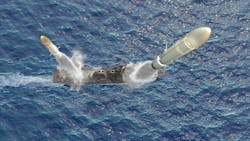Raytheon, Northrop Grumman to prototype hypersonic missile defense that launches from U.S. Navy destroyers
DAHLGREN, Va. – Two U.S. military prime contractors are moving forward on in a major project to defend military assets from hypersonic missiles with weapons designed to attack these incoming missiles in their most vulnerable phase of flight.
Officials of the U.S. Missile Defense Agency (MDA) in Dahlgren, Va., announced two multimillion-dollar orders on Tuesday for the Glide Phase Intercept (GPI) program.
Missile-defense experts from Northrop Grumman Corp. and Raytheon Technologies Corp. will refine their GPI concepts by building prototypes for real-world testing. The two companies have been working on defining GPI concepts since late 2021.
GPI is to provide regional hypersonic missile defense by launching specially modified missiles from U.S. Navy surface warships that engage and destroy incoming hypersonic missiles as they glide through the boundary between space and Earth's atmosphere. Hypersonic missiles can reach speeds faster than Mach 5, which is nearly 4,000 miles per hour.
This week's contract modifications went to the Northrop Grumman Propulsion Systems segment in Chandler, Ariz., for $83.7 million; and to the Raytheon Missiles & Defense segment in Tucson, Ariz., for $88.7 million. The companies will continue to develop and refine their GPI concept during technology development.
The GPI interceptor will launch from the vertical launch systems aboard Navy Arleigh Burke-class destroyers to intercept incoming hypersonic missiles in their glide phase of flight. GPI will bridge the gap between the Navy SM-3 and SM-6 missiles, which attack enemy missiles at various phases of their flights.
The GPI prototypes will be designed will fit into the current Aegis ballistic missile defense system” which fires from a naval vessel’s vertical launching system. The GPI will involve new interceptors and modifications to the Aegis weapon system necessary to launch them.
On this week's orders, Northrop Grumman will do the work in Chandler, Ariz.; Linthicum, Md.; Colorado Springs, Colo.; San Diego; and Huntsville, Ala. Raytheon will do its work in Tucson, Ariz.; El Dorado Hills, Calif.; Aurora, Colo.; Tewksbury, Woburn, and Andover, Mass.; McKinney, Texas; and Huntsville, Ala. Both companies should be finished by March 2024.
For more information contact Northrop Grumman Propulsion Systems online at www.northropgrumman.com/space/propulsion-systems, Raytheon Missiles & Defense at www.raytheonmissilesanddefense.com, or the Missile Defense Agency at www.mda.mil.
About the Author
John Keller
Editor-in-Chief
John Keller is the Editor-in-Chief, Military & Aerospace Electronics Magazine--provides extensive coverage and analysis of enabling electronics and optoelectronic technologies in military, space and commercial aviation applications. John has been a member of the Military & Aerospace Electronics staff since 1989 and chief editor since 1995.
